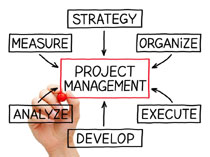Projects, Processes and People
 The more people, projects and clients a company has, the more complexity develops. To manage all of these productively, there must be processes in place. When your company had 10 or even 20 employees, allocating resources to a project was relatively easy. As growth ramps us, throwing people at problems no longer works. Overhead increases and the leader who is asleep at the wheel will begin to lose profitability. Now you need good managers. However, growing organizations require managers who are knowledgeable about what an effective process looks like, how to manage it, when and how to improve it and how to get work accomplished through people.
The more people, projects and clients a company has, the more complexity develops. To manage all of these productively, there must be processes in place. When your company had 10 or even 20 employees, allocating resources to a project was relatively easy. As growth ramps us, throwing people at problems no longer works. Overhead increases and the leader who is asleep at the wheel will begin to lose profitability. Now you need good managers. However, growing organizations require managers who are knowledgeable about what an effective process looks like, how to manage it, when and how to improve it and how to get work accomplished through people.
“A cardinal principle of Total Quality escapes too many managers: you cannot continuously improve interdependent systems and processes until you progressively perfect interdependent, interpersonal relationships.” Stephen R. Covey
As your organization continues to grow, it’s important to review current processes to ensure they still add value in the future. At a certain point in organizational growth, the CEO no longer has the ability to keep his or her finger on every aspect of the company, can no longer catch problems before they happen and can no longer make every decision. When your company reaches the point that one person can no longer manage it, processes become an important strategic tool.
Now it’s time to think about which processes are critical for where the company is in its current stage of growth. Here’s the simple process for doing that. Engage each staff member in a discussion about what processes are working and which are not. Put names to those processes so everyone has an anchor to reference. For example:
- Finding New Clients This falls into the sales process. What is your organization’s sales process? Is it effective? Are there key indicators in place to tell when it is or is not effective?
- Recruiting, Hiring, Training and Employee Development These all fall under the human resources process. Have the processes for each of these been identified? Do your leaders know what the HR process looks like? If the CEO left or turned operations over to someone new, would the leader be able to determine what the HR processes are?
- Financial, Marketing, Production Apply the same thinking and evaluation process to each of these.
Asking critical questions during the evaluation process will help. These questions include:
- Are processes captured, written down and reviewed regularly?
- Are these processes being followed?
- If processes are in place, are they working?
- Has the company identified key success indicators, and are they being tracked and measured?
- Is there a project management template?
Answers to these questions are critical because an efficiently run business is a profitable business and the sooner effective processes are in place, the sooner the company will begin becoming profitable. Inefficiency affects staff morale and disengagement rears its ugly head. When processes are in place, people feel confident that the activity they are performing will yield the same results as it did previously. When processes are missing, people lose that confidence. Inefficiencies create tension and the entire company can feel like it’s a stretched rubber band waiting to break.
Creating processes is not the end. Monitoring and testing these systems is essential to success. This is the best way to determine if the process is still effective and helping you meet your goals. The way to monitor processes is by asking:
- How do we identify processes that work?
- Is the CEO willing to let go of processes that no longer work and create new ones that do work?
- How do we know what isn’t working and why?
- How do we determine who should be involved in creating or revising processes?
- How can we encourage people to speak up about processes that need to be updated or improved?
“Almost all quality improvement comes via simplification of design, manufacturing…layout, processes, and procedures.” Tom Peters
It is difficult to step back and analyze processes when it comes to how work is done in a company. Too often broken processes remain in place due to a lack of training – people simply jump in and start doing whatever needs to be done and are never introduced to the correct way. This isn’t because there isn’t a correct way, typically it’s because no one has the time to make training a priority. Too many times, corrections to the work processes are made on the fly or worse, after the project or product is complete and errors become known. The first step is to analyze the workflow and break it down into processes. This helps leaders recognize that getting bills out on time won’t happen if the process of how time or projects are turned in is broken.
Thank you for reading this blog. Questions? Comments? Call 404-320-7834 or email This email address is being protected from spambots. You need JavaScript enabled to view it. or visit www.performstrat.com,